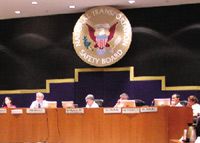FDA hears of problems with Med Guides
The Food and Drug Administration's "Medication Guide" program, set up nine years ago as a major avenue of informing patients about risks or special issues with certain drugs, has a host of problems, according to pharmacists and other witnesses at a recent hearing.

A public hearing, aimed at improving the guides, was held last month in Washington, D.C. At the hearing, the FDA heard that manufacturers often don't ship the guides, that pharmacists often don't distribute them, and that patients often find them difficult to understand and end up throwing them away.
Originally conceived as a requirement for only a few drugs, Med Guides are now required for 240 products, according to FDA.
"One of our principal concerns is the lack of research concerning the role, scope, and effects of the medication guide program on patient understanding and behavior," McEvoy said. "And one of our principal recommendations would be that we need to do research to define what will work best and what is in the best interest of patients."
Marcie Bough, Pharm.D., federal regulatory affairs director with the American Pharmacists Association, told the FDA, "Unfortunately, the Med Guide program is becoming a burden on the pharmacists' time, workflow, and ability to provide patient care." She said APhA asked 396 pharmacists about the Med Guides and found that less than 10% of the providers said the program was working at least moderately well. "The majority of the respondents said that Med Guide information overlaps with other information that patients are receiving, such as CMI, that there is too much information in the Med Guide for some patients to understand, and that it is not written at a consumer-friendly, health literacy level."
Bough went on to say that pharmacists complain they do not get enough copies of Med Guides for distribution, and because the documents have different sizes and formats, there are constant problems in storing, organizing, and finding them.
Several speakers indicated that the time has come to allow electronic distribution of the guides, but there were different ideas on how that might be done. Pharmacy organizations indicated concern that electronic distribution would shift the cost of printing to pharmacists. Speakers noted that the guides were each originally conceived as perhaps two pages long but that now many are several times that length. A number of witnesses urged that such risk communication be done by physicians or that the guides be given to the patient at the point of prescribing.
Paul Seligman, M.D., MPH, associate director of Safety Policy and Communication in FDA's Center for Drug Evaluation and Research, asked whether physicians are ready to accept that burden on their time.
Jeffrey Stoddard, M.D., VP of Covance, a research and testing company, said, "My sense is that increasingly physicians are acknowledging that risk communication is a critical part of what they have to do and that often it does involve formal mechanisms, including documentation."
Bough said APhA "strongly encourages the agency to include in its review of the Med Guide program the prospect of expanding access to the pharmacist-provided medication therapy management or MTM services for patients on medications that require a Med Guide."
A transcript and other information about the meeting are due to be posted on the FDA Web site. Comments on Med Guides will be accepted through July 12 at: http:// http://www.fda.gov, under "Reference Room," then under "Dockets."
THE AUTHOR is a writer based in the Washington, D.C., area.
How PBMs Impede Pharmacists’ Ability to Perform Clinical Services | APhA 2025
March 31st 2025Antonio Ciaccia, President of 3 Axis Advisors, led a discussion on pharmacy benefit manager reform and how the inability to pass legislation has led to increased financial hardships in community pharmacy.